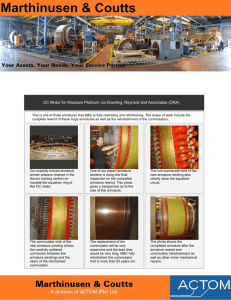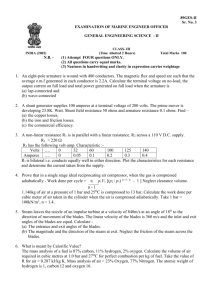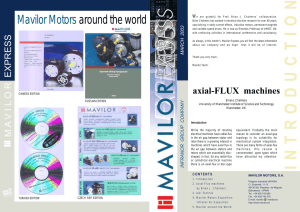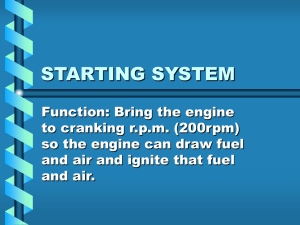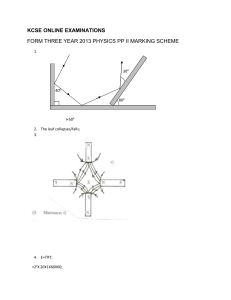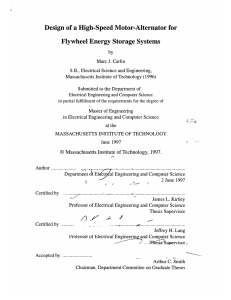AXIAL REVIEW OF
advertisement
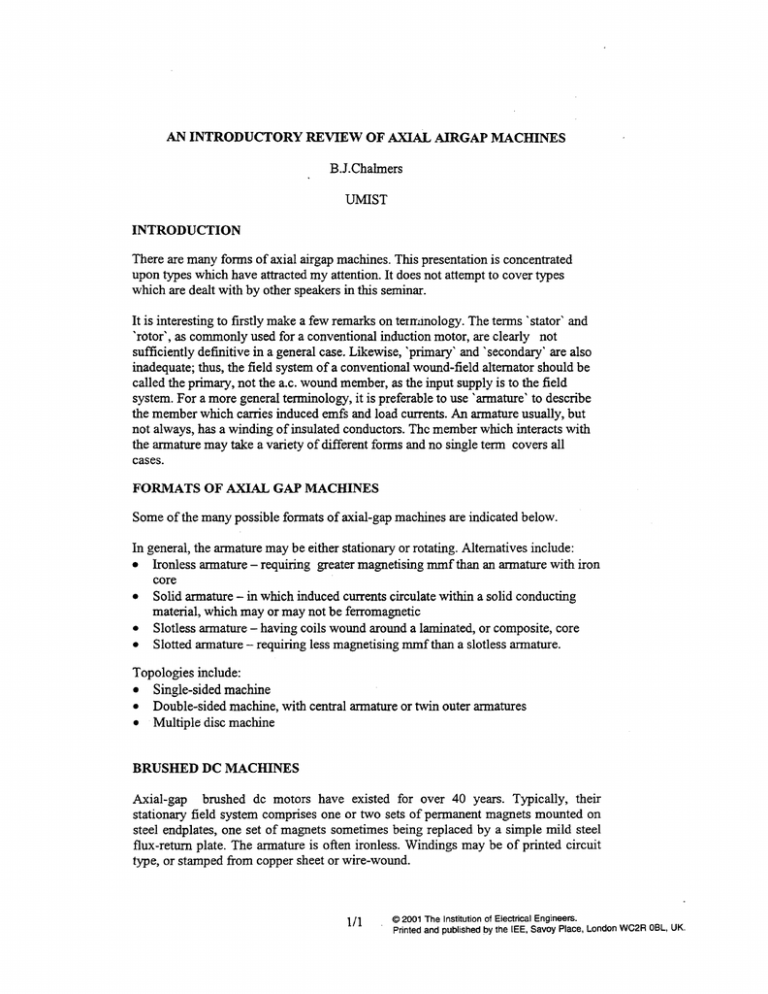
AN INTRODUCTORY REVIEW OF AXIAL AIRGAP MACHINES B.J.Chalmers UMIST INTRODUCTION There are many forms of axial airgap machines. This presentation is concentrated upon types which have attracted my attention. It does not attempt to cover types which are dealt with by other speakers in this seminar. It is interesting to firstly make a few remarks on ternmology. The terms ‘stator‘ and ‘rotor’, as commonly used for a conventional induction motor, are clearly not sufficiently definitive in a general case. Likewise, ‘primary‘ and ’secondary’ are also inadequate; thus, the field system of a conventional wound-field alternator should be called the primary, not the a.c. wound member, as the input supply is to the field system. For a more general terminology, it is preferable to use ‘armature’ to describe the member which carries induced emfs and load currents. An armature usually, but not always, has a winding of insulated conductors. Thc member which interacts with the armature may take a variety of different forms and no single term covers all cases. FORMATS OF AXIAL GAP MACHINES Some of the many possible formats of axial-gap machines are indicated below. In general, the armature may be either stationary or rotating. Alternatives include: Ironless armature - requiring greater magnetising mmf than an armature with iron core Solid armature - in which induced currents circulate within a solid conducting material, which may or may not be ferromagnetic Slotless armature - having coils wound around a laminated, or composite, core Slotted armature - requiring less magnetising mmf than a slotless armature. Topologies include: Single-sided machine Double-sided machine, with central armature or twin outer armatures Multiple disc machine BRUSHED DC MACHINES Axial-gap brushed dc motors have existed for over 40 years. Typically, their stationary field system comprises one or two sets of permanent magnets mounted on steel endplates, one set of magnets sometimes being replaced by a simple mild steel flux-return plate. The armature is often ironless. Windings may be of printed circuit type, or stamped from copper sheet or wire-wound. 1/1 , 0 2001 The Institution of Electrical Engineers. Printed and published by the IEE, Savoy Place, London WC2R OBL, UK. Fig.1 shows an exploded view of a disc-armature c'.c motor [l]. Attributes claimed for these motors include fast response, high efficiency, good commutation and high power-to-weight ratio [2]. SOLID ARMATURE MACHINES The earliest example of an axial-gap machine with solid armature was the Faraday disc. The rotating copper disc 'armature' required sliding contacts for current collection and the space utilisation was very poor. The family of eddy current machines, covering couplings, brakes and dynamometers, have solid 'armatures' in which an iron member carries both flux and induced currents. Fig.:! shows a high-performance eddy-current dynamometer which was developed for use in commercial testing of automotive engine systems [3]. This is a double-sided homopolar inductor machine in which pulsation of unidirectional flux is produced by rotation of a toothed rotor, causing power to be dissipated as eddycurrent losses in twin stationary loss members of pure iron. The rotor is a simple toothed member flame-cut from boiler plate. The symmetrical arrangement, with a dc excitation coil and a loss member on each side, minimises magnetic asymmetry and axial forces. Eddy currents flow in the plane face of each loss member adjacent to the airgap and heat is removed by water flowing in ciiicumferential channels in the faces of the lossplates remote from the airgap. Loadings in these machines are very hgh. Thus, peak airgap flux density is about 1.75 T. Electric loading in the loss members is about 160 Nmm of periphery. Designed loss density at rated power is 100 W/sq.cm. which is several times that occurring in the largest turbine generators. The range of production machines had ratings of 70 kW@12,000 revlmin, 165 kW@10,000 rev/min, 300 kW@7,500 rev/min and 500 kW@4,500 redmin. The rotor diameter of the 500 kW machine was just 0.61 m. BRUSHLESS MACHINES As for conventional brushless dc motors, the corresponding arrangements of axial gap machines have stationary armatures and rotating permanent-magnet field systems. A variety of topologies have been developed. Fig.3 illustrates the double-sided Torus machine with a central stator and an airgap winding [4]. A simple toroidal strip-wound stator core carries a slotless toroidal winding which may have any chosen number of phases. For dc generator applications, rectifiers may conveniently be mounted on the stator casing. Machines of this type have been developed for a variety of wplications as motor or generator [51. Again, the symmetrical arrangement minimises mechanical unbalance but special attention has to be given to axial magnetic forces during assembly. Analysis has shown that optimal Torus designs have magnet thickness in the range one to two times the winding thickness, so magnet costs may present a problem. A more economic solution may be offered by slotted strip-wound stator cores, which are now available. Fig.4 shows a single-sided machine with slotted stator developed for a motor-in-wheel drive for a solar powered vehicle [6]. The stator had an outside diameter of 260 mm. 112 An extra thrust bearing was provided to support the axial force exerted by the magnets. This successfbl design had a high efficiency (c. 94%), as necessary for this application. A double-sided construction with twin slotted stators and a central permanent-magnet rotor would offer a symmetrical arrangement with good space utilisation. In that case magnet flux would pass straight through the rotor from one stator to the other. Multiple disc construction is applicable when it is iesired to produce high output and rotational forces impose a limit on rotor diameter. Fig.5 shows a multiple-disc, highspeed generator for which special attention was given to mechanical design [7]. The armatures are ironless and magnet flux passes through the machine from end to end. INDUCTION MACHINES As usual for induction motors, air gap length must be small and slotting effects must be controlled. Axial-gap induction motors should therefore use slotted strip-wound stators with small slot openings. Slot skew, usually in the rotor, is also desirable and achievable. Again, single-sided construction necessitates attention to axial forces. Use of twin outer stators and a central cage rotor with ’straight through flux’ offers a symmetrical arrangement. REFERENCES [ 13 Campbel1,P: “Principles of a permanent-magnet axial-field dc machine”, Proc.IEE, 121, December 1974, pp.1489-1494. [2] Corbett,A, and Mohamad,MT: “The disc armature dc motor and its applications”, IEE Conf. Pub. No.136, Small Electrical Machines, *976.pp.59-62. [3] Chalmers,BJ, and Dukes,BJ: “High-performance eddy-current dynamometers”, IEE Proc., 127, January 1980, pp.20-28. [4] Spooner,E, and Chalmers,BJ: “TORUS- a slotless toroidal-stator permanentmagnet generator”, IEE Proc,B, 139,January 1992, pp.497-506. [5] Chalmers,BJ, Spooner,E, Honorati,O, Crescimbini,F, and Caricchi,F: “Compact permanent-magnet machines”, Electric Machines and Power Systems, 25,6,1997, pp.635-648. [6] Patterson,D, and Spee,R: “The design and development of an axial flux permanent magnet brushless dc motor for wheel drive in a solar powered vehicle”, IEEE IAS Conf. Rec., Denver, Vo1.1,1994,pp.188-195. [7] Etmad,S: “High speed permanent magnet axial flux generator”, IEE Seminar on Permanent Magnet Materials - Fundamentals, Design and Application, July 2000. 1I3 Fig.1. Disc armature dc motor Fig.2. Eddy current dynamometer with twin lossplates h- Shofi -.- -- Fig.3. Double-sided generator with air-gap winding Fig.4. Single-sided motor-in-wheel Rotor S i c Cooling F3n CZsi3g Fig.5. Multiple-disc generator 114
